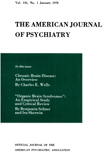Neuroleptics, catecholamines, and psychoses: a study of their interrelations
Abstract
The authors examined central catecholamine metabolism in various symptomatological psychotic disorders and the relationship between the biochemical and therapeutic action profiles of neuroleptics. Haloperidol and (to a lesser entent) chlorpromaziner icrease the dopamine (DA) turnover in the central nervous system, but the authors influenced; oxypertine has the reverse effect. The authors question whether disorders of DA-metabolism underlie or result from disorders of motor activity, postulating that the hyperdopaminergic activity observable in psychoses is dependent on motor hyperactivity rather than on "true" or psychotic symptoms such as delusions and hallucinations.
Access content
To read the fulltext, please use one of the options below to sign in or purchase access.- Personal login
- Institutional Login
- Sign in via OpenAthens
- Register for access
-
Please login/register if you wish to pair your device and check access availability.
Not a subscriber?
PsychiatryOnline subscription options offer access to the DSM-5 library, books, journals, CME, and patient resources. This all-in-one virtual library provides psychiatrists and mental health professionals with key resources for diagnosis, treatment, research, and professional development.
Need more help? PsychiatryOnline Customer Service may be reached by emailing [email protected] or by calling 800-368-5777 (in the U.S.) or 703-907-7322 (outside the U.S.).



